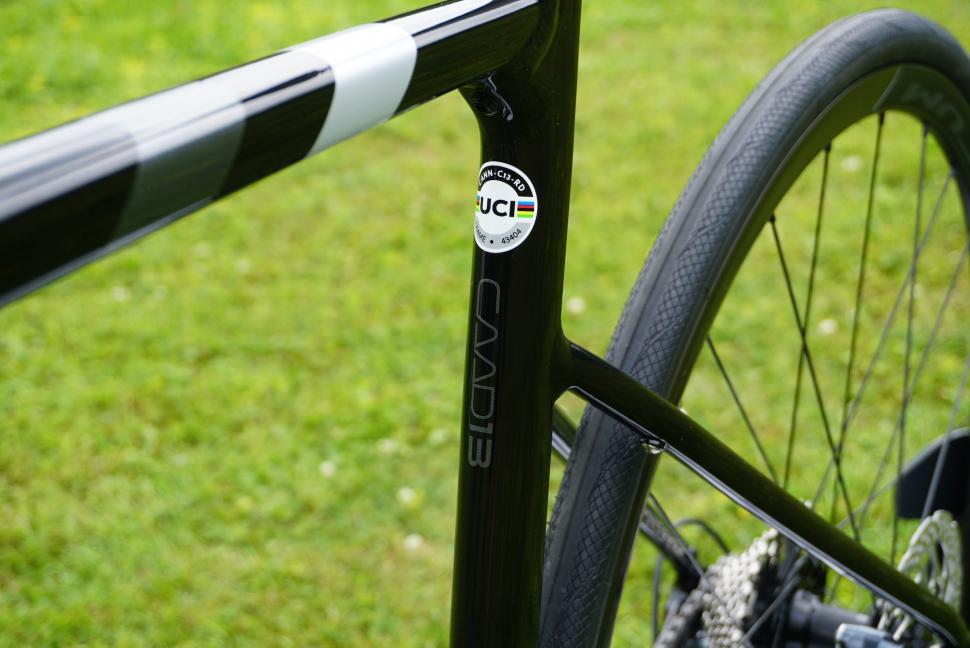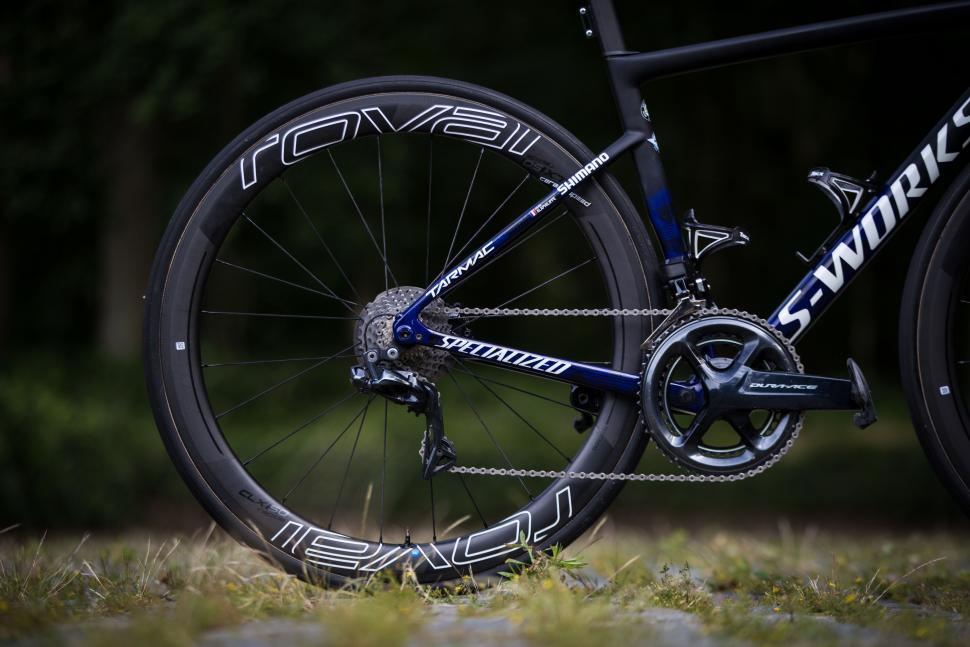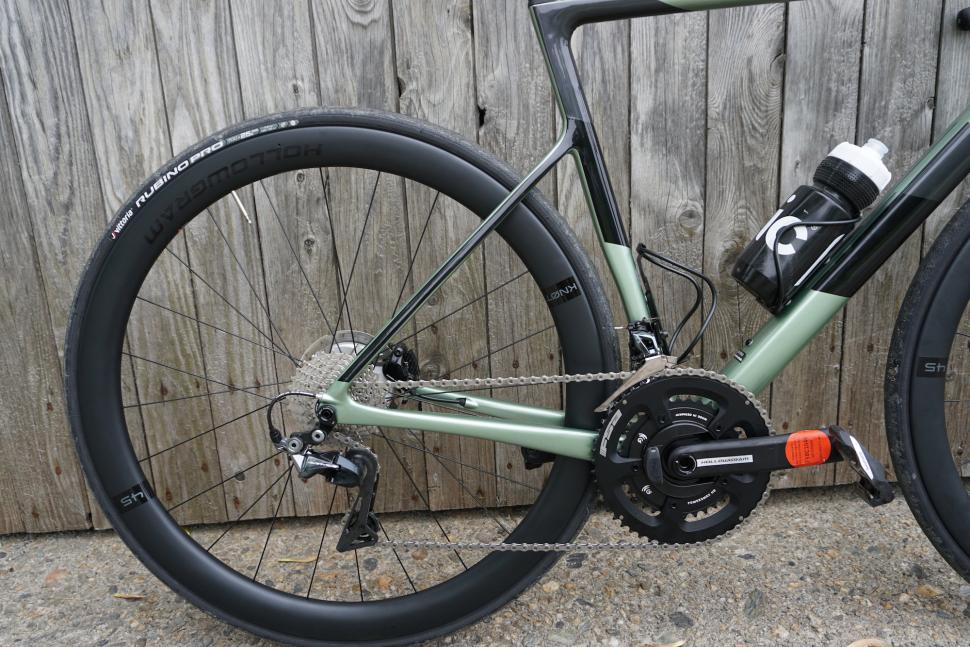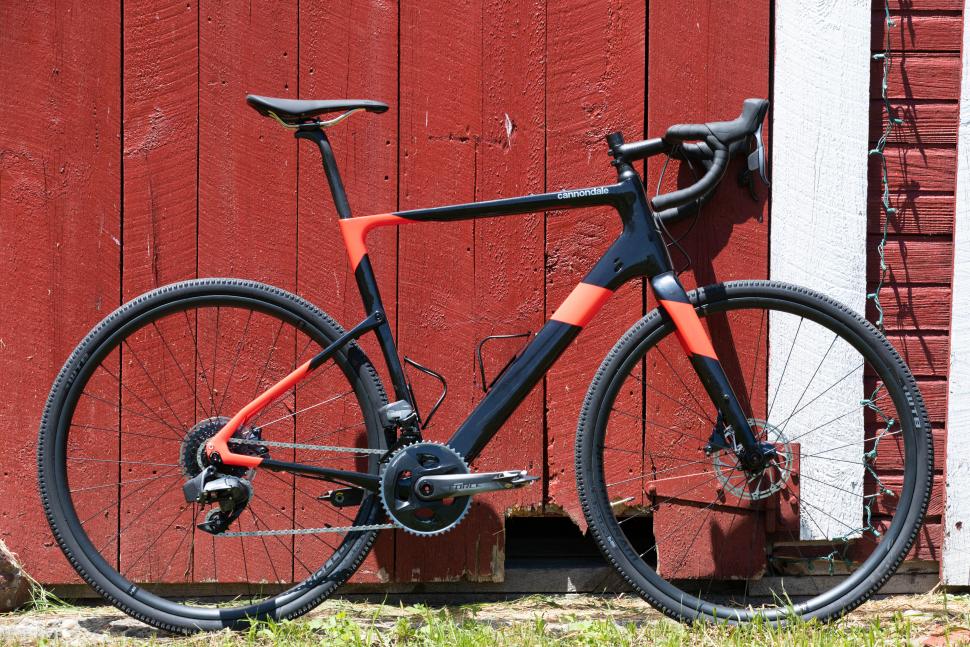- News
- Reviews
- Bikes
- Accessories
- Accessories - misc
- Computer mounts
- Bags
- Bar ends
- Bike bags & cases
- Bottle cages
- Bottles
- Cameras
- Car racks
- Child seats
- Computers
- Glasses
- GPS units
- Helmets
- Lights - front
- Lights - rear
- Lights - sets
- Locks
- Mirrors
- Mudguards
- Racks
- Pumps & CO2 inflators
- Puncture kits
- Reflectives
- Smart watches
- Stands and racks
- Trailers
- Clothing
- Components
- Bar tape & grips
- Bottom brackets
- Brake & gear cables
- Brake & STI levers
- Brake pads & spares
- Brakes
- Cassettes & freewheels
- Chains
- Chainsets & chainrings
- Derailleurs - front
- Derailleurs - rear
- Forks
- Gear levers & shifters
- Groupsets
- Handlebars & extensions
- Headsets
- Hubs
- Inner tubes
- Pedals
- Quick releases & skewers
- Saddles
- Seatposts
- Stems
- Wheels
- Tyres
- Health, fitness and nutrition
- Tools and workshop
- Miscellaneous
- Tubeless valves
- Buyers Guides
- Features
- Forum
- Recommends
- Podcast
feature
 cannondale caad1330.JPG
cannondale caad1330.JPGWhat are dropped seatstays good for? Should you get a bike with them?
Trends come and go in the bike world. One that won’t have escaped your notice is the dropped seat stay design. But why are all the bike companies at it?
Rewind the clock a couple of decades and all road bikes were made from skinny steel tubes with a double diamond design. Then along came Mike Burrows in the 1990s and, with Giant Bicycles, introduced the radical compact frame design dubbed TCR. Key to this design was a small rear triangle providing weight and stiffness benefits.
It took a long while for the design to be accepted but it has now influenced most modern bike designs. While it didn't have radically dropped seat stays like we're seeing today, it did lay the foundations.
We don't know who really started the trend for dropped seat stays, but Swiss brand BMC is often credited with doing it first on the Impec, a futuristic carbon frame designed and built by robots. BMC's main reason for dropping the rear stays was to provide more ride comfort with improved lateral stiffness.
“On the impec as well a lower-slung seat stay and special flex zones in this area provide for the typical BMC mix of ride comfort with lateral stiffness and absolute handling precision. The low seat stay is a feature that you very quickly learn to value, especially on longer tours and the worst kinds of roads," explained BMC at the Impec launch. This design study has influenced all BMC road bikes since.
How popular is this trend?
We've been seeing a lot of new bikes launched this year with dropped seat stays, suggesting we're clearly in the midst of a new trend. We wanted to put some numbers on this increased popularity so partnered with 99 Spokes, a bike comparison website, to crunch some numbers. The results make for interesting viewing.
| Year | Total | Dropped | Standard |
| 2015 | 147 | 6 | 141 |
| 2016 | 126 | 9 | 117 |
| 2017 | 208 | 25 | 183 |
| 2018 | 242 | 38 | 204 |
| 2019 | 348 | 81 | 267 |
| 2020 | 94 | 30 | 64 |
The data for 2020 model year bikes is not complete yet, but even allowing for that incomplete data set it's clear the number of bikes with dropped seat stays has only increased in popularity. It doesn't show any sign of replacing traditional seat stay designs just yet though.
"This has been an interesting trend to watch in recent years; particularly in that it’s not limited to a subset of cycling disciplines, but appears across a wide range from gravel to road racing. Also worth noting is the parallel trend towards disc brakes. Road bikes with dropped seat stays and rim brakes can be found, but we do see a much stronger correlation between dropped seat stays and disc brakes. Frame designers may be afforded greater flexibility in the positioning of the seat stays when they don’t need to accommodate a rear rim brake mount," commented Scott at 99Spokes.
Comfort matters
Comfort is a key reason for lowering the seat stays on a road bike then. Road bikes have gotten incredibly light and stiff since the early days of carbon fibre development, probably to the point it’s going to take a major leap in material development for any more major gains in these areas.
But our roads aren’t getting any smoother, and so bike designers have started focusing on comfort.
Along with increasing tyre clearance, frame design has been a key target for achieving more of compliance. That's the ability of the bike to cushion you, to an extent, from the vibrations and impacts generated when riding over rough roads.
There has been greater demand for bikes that combine the speed and performance of a pro race bike but are easier to live with on poorly surfaced and maintained roads. It’s given rise to the huge popularity of endurance road bikes. Bikes designed to be comfortable yet fast, stiff and light.
Bike designers point towards a smaller rear triangle, achieved by dropping the seat stays further down the seat tube, as a way of increasing comfort. When the saddle is pushed down, it flexes the seat post and this, in turn, tries to bend the seat tube. Lowering the point at which the seat stays meet the seat tube allows the seat tube to bend more, increasing the range of movement at the saddle.
It’s not just endurance bikes that are getting this comfort focus. Even the latest race bikes from the big brands are going down the same route. There was some controversy when Cannondale unveiled its brand new SuperSix Evo, a bike that had held onto a traditional frame design, with dropped seat stays.
According to Cannondale, the new Evo bests the previous bike provides an 18% improvement in compliance compared to the previous model. That's not just down to the stays, but also the seat post and new internal seat clamp.
Aero matters too
It's not all about comfort. Bike designers also claim aerodynamic improvements from the compact rear triangle created by the dropped rear stays. Dropped stays have become almost commonplace on aerodynamic, where they first appeared, to regular all-round road race bikes getting the same treatment.
Ribble’s Head of Product Design Jamie Burrow lists numerous benefits. "The benefits over a traditional rear triangle are: (1) more aerodynamic flow from stays to the rear wheel; (2) the seat tube offers seat post compliance for a more comfortable ride; (3) smaller triangles are stiffer, keeping the rear triangle stiffer and maintaining power transfer to the back wheel."
Specialized adopted the dropped seat stay design many years ago. The second-generation Venge aero road bike introduced them to the aero line, and the sixth-generation Tarmac road bike got the same dropped seat stay treatment. On this bike, Specialized lists the dropped stays, along with other changes, as contributing to the new bike being 45 seconds faster over 40km compared to the old model.
Colnago has resisted the trend, taking a more traditional approach to frame design, but that said it's latest aero road racer the V3RS has incorporated the dropped seat stays. Colnago’s designer Davide Fumigalli says there are benefits to dropped stays, but adds that they’re not always the right solution.
“We started dropping the seat stay a few years ago with the K-zero (mainly for Aerodynamic purpose) and C-rs (comfort and side stiffness) but then we didn’t use this option for V2 and C64. It’s not the ultimate solution to anything, sometimes it works, sometimes not,” he explains.
"It’s always about what are you looking for…for this project [V3RS] we think the “slightly dropped” seat stay is the correct balance."
Alternative solutions
It's obviously creating bikes that look largely the same. And many people aren’t fans of the aesthetic of the dropped stays. But tradition has rarely stood in the way of technological progress in the cycling world, aside from the UCI rule book. And aero has become the biggest focus for many bike brands, especially those with demanding pros to cater for.
There is a limit to how much vertical compliance can be built into an otherwise stiff frame. No wonder some bike companies are looking at more radical solutions to meeting the demands of comfort and aerodynamics.
Trek's IsoSpeed negates the dropped seat stays for a clever design that decouplers the seat tube from the rest of the frame so it's free to flex back and forth. Cannondale has added pivots to its Topstone Carbon gravel bike along with dropped stays to increase the comfort. Specialized meanwhile drops a seat post into an oversized seat tube to increase the range of deflection.
Then, of course, there is the increased tyre size that nearly all new bikes are now capable of being fitted with.
It's not just road bikes. Gravel, adventure and all-road bikes are taking it too another level. Cannondale’s Topstone Carbon is perhaps the ultimate expression of this idea. By placing a pivot bearing at the seat stay and seat tube junction, it aims to increase the degree of bending force at the seat tube to offer, in its words, up to 30mm of compliance.
Summary
But do drop seat stays really make a dint of difference? Here at road.cc, we’ve ridden hundreds of the latest bikes over the last decade, and performance, when measured across all metrics, has definitely improved. They feel faster, more efficient and more comfortable. But pinning all those improvements to the dropped seat stays is an impossible conclusion to draw.
In a market where the designers are chasing the same goals and limited by the same rule book, there are only so many avenues bike designers can explore. It seems the dropped seat stays achieves the desired increased comfort and less tangible aerodynamic improvement, and as a result, are here to stay.
Is it a bad thing or just another phase in the evolution of the road bike? Time to hand over you you so let us know what you think below.
David worked on the road.cc tech team from 2012-2020. Previously he was editor of Bikemagic.com and before that staff writer at RCUK. He's a seasoned cyclist of all disciplines, from road to mountain biking, touring to cyclo-cross, he only wishes he had time to ride them all. He's mildly competitive, though he'll never admit it, and is a frequent road racer but is too lazy to do really well. He currently resides in the Cotswolds, and you can now find him over on his own YouTube channel David Arthur - Just Ride Bikes.
Latest Comments
- ktache 1 hour 27 min ago
The batteries were not the easiest to find, and the brackets broke easily. The switch was far better than the D cell quick release ever readys that...
- ktache 1 hour 53 min ago
There are people out there who will make you the belt out of your old tyre.
- chrisonabike 1 hour 54 min ago
Furry dice and an air freshener for your helmet.
- AidanR 2 hours 7 min ago
Looking at the pictures in the linked article, the bikes aren't actually inconsiderately parked. The only issue is that they're on private property...
- Simon E 2 hours 42 min ago
Ah yes, those are hopefully not the 'master craftsmen' that has constructed a wide range of shoddy Italian cars and motorbikes over the years with...
- Simon E 3 hours 5 min ago
A SuperSix is definitely not an all-rounder....
- JLasTSR 3 hours 11 min ago
Since most of.my clothes come.from.charity shops.or the eBay nearly for.nothing clothing section I don't tend.to.worry if they wear out, I am also...
- chrisonabike 3 hours 57 min ago
Just get them to walk a treadmill - or better, ride exercise bikes to power path lighting.
- AidanR 4 hours 33 min ago
So his advisers were trying to move funds around to cover losses, but in a way that needlessly created additional liabilities? It would have been...








Add new comment
48 comments
Nine comments from people who have never ridden a bike with dropped seat stays but are fully qualified to post their expert opinions/knowledge/snide, and a single comment from someone who has.
I like them. My old GT Timberline MTB had extended stays with the small triangle of stay, top tube, seat tube. That bike rocked. Broke the seat landing short on a 6' double but kept it. Ndo over the lip, rolled down then lay on the grass recovering ages. Eventually bent the forks the other way hence increasing wheel base probably from too many over landings.
Compression, stretch, why not spring flex.
Surely lower stays would allow cushioning flex and provide a higher stiffness towards drive thus traction and power transfer improvement. I know I don't get that on my high stays 1990? light weight road bike, the arse end skids early.
Modern tolerances of materials and manufacturing as well as +30 years of continual R&D growth look like they have found a durable combination that allows lower stays.
Cushion without excess weight such as axled suspension fulcrums plus a firm hold of drive rigidity.
I look there when I ride sometimes but that's because I'm rolling true with nearly nothing between my tyre and my stays. Friction sux.
How does dropping the point where the seat stays meet the frame increase tyre clearance? It puts the junction between seat tube and seat stays closer to the wheel, therefore requiring more extreme curvature of the seat stays to create the required clearance.
I'm calling BS on that one.
Fashionable is the right word because these design elements don't actually make you faster in the same way compact framesets don't make you faster. Usually the manufacturer sees a way of cutting costs in production. The compact frameset is a case in point. Giant saw a way of standardizing frame production for both mens and womens bikes, cutting costs and making the business more profitable. If they had been significantly better than traditional designs then we would've saw Laurent Jalabert winning the TDF.
wouldn't a longer seat stay be more compliant than a shorter one given exact same tube diameters and design/composition, the more equal lengths (wider angles of the rear triangle comparatively is stronger which means stiffer like for like than a triangle that is more isosceles in design which is the traditional rear triangle.
Also, the TCR compact frame had sod all to do with weight and stiffness, it just meant Giant could produce fewer sizes that fit more people by allowing much more range in seatpost height
True, and those early ally frames were quite harsh, but with carbon, and especially the later thin carbon seatpost, comfort appeared in spades. Both the current TCR and Defy score well in the comfort stakes.
Anyone who believes dropped stays has any meaningful effect on anything needs their head examined, but it's a modern look that that gives the impression of cutting edge design so that's what sits at the top of the pyramid as the aspirational frameset
It also has the reverse effect. The combination of pig-ugly and look-at-me narcissism put me right off buying one. I put it squarely on the expirational side.
I smell the distinct whiff of marketing twaddle. A fashion trend to sell more bikes.
Just another fashion accessory i'm afraid, just like disc brakes.
But if it floats your boat, splash the cash.
God, how I miss hammering out cotter pins!
Disagree - Discs are an engineering workaround for the poor braking performance of carbon rims. They only are viable because the outdated UCI weight limit means the extra material needed to reinforce the frame for them is viable. If the UCI dropped a Kg off that weight limit, disc bikes would become rarer, but there'd be a bunch of very expensive rim braked bikes marketed as "featherweight climbing bikes"...
I hadn't heard of dropped seat stays, had to look at the pictures to understand what you meant.
I don't think I've seen one in the wild, but god that's ugly. IMO. YMMV.
Get a university to do flex tests and aero tests. However it'll be in the noise, especially flex. Seat tubes plus seat post isn't going to flex much at all. If it did the joints would crack.
Whereas the fashion quotient would show a marked differential. QED.
Got a Cube Attain... seems comfy enough. That Topstone is crazy low!
As for the history, did Giant's TCR predate GT's 'triple triangle', another effectively dropped stay design, supposedly with the same benefits. This dates friom 1995, so pretty contemporaneous with the launch of the TCR.
Yeah that's what I thought as soon as I saw it. I had a 90s GT MTB for a while.
I have to say that from an engineering viewpoint, the GT triple triangle design is probably a lot stiffer than the other lowered stay designs. And while the claims about a narrower triangle at the reat being stiffer are likely to be true, the fact that forces are not directed through a common point means that frame flex would occur elsewhere around the seatpost.
If you ask me, I think this dropped stay design is just another bit of fashion. GT's triple triangle makes sense because the stays are extended to the top tube.
Pages